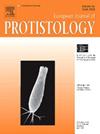中国圈养蛇类中意外高多样性的拟蛇类
IF 1.6
2区 生物学
Q4 MICROBIOLOGY
引用次数: 0
摘要
蛇经常被当作宠物饲养,被认为是病原原生生物的重要宿主。副寄生蜂是一种寄生于多种宿主的单细胞原生生物,通过粪-口途径传播。一些物种具有人畜共患风险,危及人类和动物的健康。本研究报告了中国6种圈养的非本地蛇类中拟拟蛇类的多样性和流行率。在中国26个省份,包括5个开放养殖场、16个私人养殖场和5个宠物店,共收集了753份非本地蛇的粪便样本。PCR扩增核ITS1‐5.8S-ITS2区,研究拟拟虫的感染率,并通过系统发育分析评估其亲缘关系。蛇粪中拟虫碱总阳性率为13.28%(100/753)。不同种类蛇类的感染率差异不显著,但不同繁殖环境的感染率差异显著。养殖场饲养的蛇感染率(31.62%,43/136)显著高于宠物店(13.24%,18/136)和私人饲养场(8.11%,39/481)。除爬行动物中常见的毛单胞菌外,在蛇粪中还鉴定出5种副滴虫:肌毛滴虫、鼠毛滴虫、鸡毛滴虫、莫斯科单毛滴虫和batrachorum毛滴虫。据我们所知,这是第一次在中国圈养的蛇中发现这些拟basasalids。我们的研究揭示了在蛇的肠道中有一个多样化的拟拟蛇类群落,包括一些典型的寄生在其他动物群体中的物种,如哺乳动物、鸟类和两栖动物。然而,还需要进一步的调查来确定这些拟蛇碱是否对蛇有致病作用,或者它们是否可以传播给其他动物。本文章由计算机程序翻译,如有差异,请以英文原文为准。
Unexpectedly high diversity of parabasalids in captive snakes from China
Snakes are frequently kept as pets and are considered important reservoirs of pathogenic protists. Parabasalids, single-celled protists that parasitize a broad variety of hosts, are transmitted via the fecal-oral route. Some species pose zoonotic risks, endangering the health of both humans and animals. This study reports on the diversity and prevalence of parabasalids in six captive, non-native snake species from China. A total of 753 fecal samples were collected from non-native snakes across 26 provinces in China, including five open farms, 16 private breeders, and five pet shops. The nuclear ITS1‐5.8S-ITS2 region was PCR amplified to investigate the infection rates of parabasalids and assess their kinships through phylogenetic analysis. The overall prevalence of parabasalids in the snake fecal samples was 13.28 % (100/753). While infection rates did not differ significantly among the snake species, significant differences were observed among the breeding environments. Snakes raised on farms had significantly higher infection rates (31.62 %, 43/136) compared to those from pet shops (13.24 %, 18/136) and private breeders (8.11 %, 39/481). In addition to Monocercomonas colubrorum, commonly found in reptiles, five other parabasalids were identified in snake fecal samples: Tritrichomonas musculus, Tritrichomonas muris, Trichomonas gallinae, Simplicimonas moskowitzi, and Trichomitus batrachorum. To our best knowledge, this is the first time these parabasalids have been detected in captive snakes from China. Our study revealed a diverse community of parabasalids in the intestines of snakes, including species typically parasitic in other animal groups such as mammals, birds, and amphibians. However, further investigations are required to determine whether these parabasalids have pathogenic effects on snakes or if they could be transmitted to other animals.
求助全文
通过发布文献求助,成功后即可免费获取论文全文。
去求助
来源期刊

European journal of protistology
生物-微生物学
CiteScore
4.60
自引率
20.70%
发文量
55
审稿时长
14.6 weeks
期刊介绍:
Articles deal with protists, unicellular organisms encountered free-living in various habitats or as parasites or used in basic research or applications. The European Journal of Protistology covers topics such as the structure and systematics of protists, their development, ecology, molecular biology and physiology. Beside publishing original articles the journal offers a forum for announcing scientific meetings. Reviews of recently published books are included as well. With its diversity of topics, the European Journal of Protistology is an essential source of information for every active protistologist and for biologists of various fields.
 求助内容:
求助内容: 应助结果提醒方式:
应助结果提醒方式:


